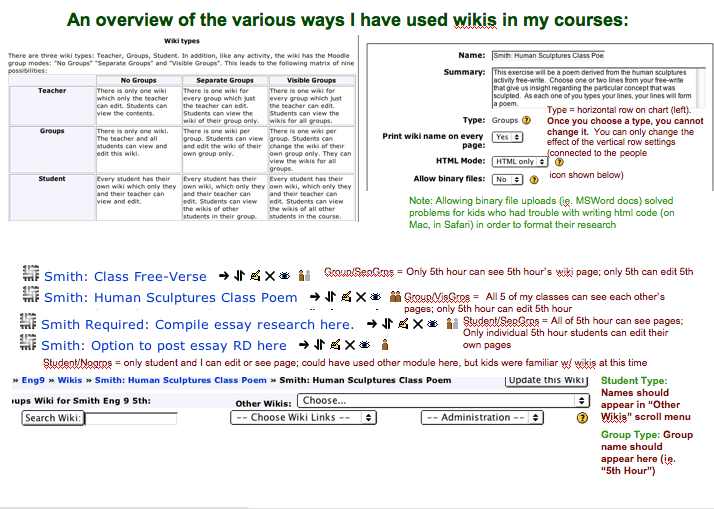Wiki: Difference between revisions
(reorganized, so course wiki was together) |
No edit summary |
||
| Line 57: | Line 57: | ||
*CamelCase describes what WikiWords look like. Multiple words, joined together without spaces, separated by changes in case. The uppercase and lowercase letters show up like the humps of camels. This linking scheme is often also called BumpyText because it could look like CaMeL_CaSe. | *CamelCase describes what WikiWords look like. Multiple words, joined together without spaces, separated by changes in case. The uppercase and lowercase letters show up like the humps of camels. This linking scheme is often also called BumpyText because it could look like CaMeL_CaSe. | ||
==Adding Pages== | |||
A useful way of building a structured contents page (as opposed to the alphabetical '''Page Index''') is to add all new wiki pages from the front page | |||
==Wiki Search== | |||
Wiki search ignores hyperlinks so it is wise to add a "Keywords:" line ahic contain the words of the the page title seperated by commas, and any other entries that you wish to be found by the search. | |||
== See also == | == See also == | ||
Revision as of 02:43, 8 September 2006
A Wiki enables documents to be authored collectively in a simple markup language using a web browser. Moodle has a Wiki module that allows you to create wikis within your courses.
Meaning of Wiki
"Wiki wiki" means "super fast" in the Hawaiian language, and it is the speed of creating and updating pages that is one of the defining aspects of wiki technology. Generally, there is no prior review before modifications are accepted, and most wikis are open to the general public or at least to all persons who also have access to the wiki server.
The Moodle wiki module enables participants to work together on web pages to add, expand and change the content. Old versions are never deleted and can be restored.
This module is based on ErfurtWiki (Ewiki), a WikiWikiWeb hypertext language, all open source.
MoodleDoc Wiki
There are certain ways (standards, conventions, best practices) we should use when creating and editing these MoodleDoc pages. They are simple.
Standard Course Wiki
Wiki as an activity module is in the process of change and there are several add in wiki modules. This is based on standard versions that come with Moodle.
Settings for Course Wiki
There are many help buttons on the settings page for a course wiki. Settings include:
- Name, Description, Type, Print wiki name on every page, HTML Mode, Allow binary files, Wiki auto-linking options, Student admin options, Optional Page Name, Choose an Initial Page, Group mode, and Visable to students. There is a sub menu
- Student admin options: Allow 'set page flags', Allow 'strip pages', Allow 'remove pages', and Allow 'revert mass changes' check offs.
- Name, Description, Type, Print wiki name on every page, HTML Mode, Allow binary files, Wiki auto-linking options, Student admin options, Optional Page Name, Choose an Initial Page, Group mode, and Visable to students. There is a sub menu
Building a Course Wiki
Here is the help link with the basics of creating a Wiki.
- Instructions for E-wiki creating pages
Here is the section in help that talks about editing Wike page content. Markups is another word for formating.
- Instructions for Course Wiki markup
- Here is another help file that is very useful as well. markdown
Confused about the difference? Well a markdown is a type of markup notation. "A rose by any other name is still a rose." Yeah, we did not invent this stuff, we just use it OK? :)
Screen Shot of Wiki Page
Editing a Wiki page is easy. Notice the HTML tool bar at the top of the content section.
Examples of Wiki Use in Moodle Courses
Screen Shot of Moodle v1.4 Wiki Use Contributed by Lesli Smith, 19 Aug 2006
CamelCase Notation
- What is a CamelCase notation? Your very first CamelCase notation you will create will look like:
[Create wiki page] Anything inside the square brackets is the page name
When this is placed on the first Wiki Page, a "?" that is a link appears. Clicking on the link in this example will take us to a new blank page called "Create wiki page".
- CamelCase notations allows pages to be linked, indexes created for catagories, and all sorts of other organizational tools to make connections. Here is the help section on CamelCase: Create pages section
- CamelCase describes what WikiWords look like. Multiple words, joined together without spaces, separated by changes in case. The uppercase and lowercase letters show up like the humps of camels. This linking scheme is often also called BumpyText because it could look like CaMeL_CaSe.
Adding Pages
A useful way of building a structured contents page (as opposed to the alphabetical Page Index) is to add all new wiki pages from the front page
Wiki Search
Wiki search ignores hyperlinks so it is wise to add a "Keywords:" line ahic contain the words of the the page title seperated by commas, and any other entries that you wish to be found by the search.
See also
- Using Moodle Chapter 11: Wikis
- RichText- help file on some format icons
- Wiki requirements - developer documentation
- Dfwiki - an alternative wiki language to ErfurtWiki, both used in Moodle.
- Wikimedia- MoodleDocs is a version of WikiMedia. Note WikiMedia is not used in Moodle (see ErfurtWiki or Dfwiki).
